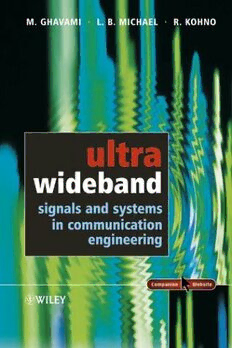
Ultra-wideband signals and systems in communication engineering PDF
Preview Ultra-wideband signals and systems in communication engineering
Ultra Wideband Signals and Systems in Communication Engineering M. Ghavami King’s College London, UK L. B. Michael Japan R. Kohno Yokohama National University, Japan John Wiley & Sons, Ltd Ultra Wideband Signals and Systems in Communication Engineering Ultra Wideband Signals and Systems in Communication Engineering M. Ghavami King’s College London, UK L. B. Michael Japan R. Kohno Yokohama National University, Japan John Wiley & Sons, Ltd Copyright ©2004 John Wiley & Sons, Ltd, The Atrium, Southern Gate, Chichester, West Sussex, PO19 8SQ, England Telephone 01243 779777 E-mail (for orders and customer service enquiries): [email protected] Visit our Home Page on www.wileyeurope.com or www.wiley.com All Rights Reserved. No part of this publication may be reproduced, stored in a retrieval system or transmitted in any form or by any means, electronic, mechanical, photocopying, recording, scanning or otherwise, except under the terms of the Copyright, Designs and Patents Act 1988 or under the terms of a licence issued by the Copyright Licensing Agency Ltd, 90 Tottenham Court Road, London W1T4LP, UK, without the permission in writing of the Publisher. Requests to the Publisher should be addressed to the Permissions Department, John Wiley & Sons Ltd, The Atrium, Southern Gate, Chichester, West Sussex, PO19 8SQ, England, or e-mailed to [email protected], or faxed to (+44) 1243 770620. This publication is designed to provide accurate and authoritative information in regard to the subject matter covered. It is sold with on the understanding that the Publisher is not engaged in rendering professional services. If professional advice or other expert assistance is required, the services of a competent professional should be sought. OtherWiley Editorial Offices John Wiley & Sons, Inc., 111 River Street, Hoboken, NJ 07030, USA Jossey-Bass, 989 Market Street, San Francisco, CA94103-1741, USA Wiley-VCH Verlag GmbH, Boschstr. 12, D-69469 Weinheim, Germany John Wiley & Sons Australia Ltd, 33 Park Road, Milton, Queensland 4064, Australia John Wiley & Sons (Asia) Pte Ltd, 2 Clementi Loop #02-01, Jin Xing Distripark, Singapore 129809 John Wiley & Sons (Canada) Ltd, 22 Worcester Road, Etobicoke, Rexdale, Ontario, Canada M9W1L1 Wiley also publishes its books in a variety of electronic formats. Some content that appears in print may not be available in electronic books. British Library Cataloguing in Publication Data Acatalogue record for this book is available from the British Library ISBN 0-470-86751-5 Typeset by the author using LaTex Software. Printed and bound in Great Britain by Antony Rowe, Chippenham, Wiltshire. This book is printed on acid-free paper responsibly manufactured from sustainable forestry in which at least two trees are planted for each one used for paper production. Contents Preface xiii Acknowledgments xvii List of Figures xix List of Tables xxvii Introduction 1 I.1 Ultra wideband overview 1 I.2 A note on terminology 2 I.3 Historical development of UWB 2 I.4 Key benefits of UWB 3 I.5 UWB and Shannon’s theory 4 I.6 Challenges for ultra wideband 5 I.7 Summary 6 1 Basic properties of UWB signals and systems 7 1.1 Introduction 7 1.2 Power spectral density 8 1.3 Pulse shape 9 v vi CONTENTS 1.4 Pulse trains 11 1.5 Spectral masks 13 1.6 Multipath 15 1.7 Penetration characteristics 18 1.8 Spatial and spectral capacities 19 1.9 Speed of data transmission 20 1.10 Cost 21 1.11 Size 21 1.12 Power consumption 22 1.13 Summary 22 2 Generation of ultra wideband waveforms 25 2.1 Introduction 25 2.1.1 Damped sine waves 26 2.2 Gaussian waveforms 28 2.3 Orthogonal waveforms and Hermite pulses 31 2.3.1 Hermite polynomials 32 2.3.2 Orthogonal modified Hermite pulses 33 2.3.3 Modulated and modified Hermite pulses 37 2.4 Orthogonal prolate spheroidal wave functions 39 2.4.1 Introduction 40 2.4.2 Fundamentals of PSWF 41 2.4.3 PSWF pulse generator 45 2.5 Designing waveforms for specific spectral masks 49 2.5.1 Introduction 49 2.5.2 Multi-band modulation 50 2.6 Practical constraints and effects of imperfections 57 2.7 Summary 59 3 Signal-processing techniques for UWB systems 63 3.1 The effects of lossy medium on an UWB transmitted signal 63 3.2 Time domain analysis 66 3.2.1 Classification of signals 67 3.2.2 Some useful functions 69 3.2.3 Some useful operations 71 3.2.4 Classification of systems 76 CONTENTS vii 3.2.5 Impulse response 77 3.2.6 Distortionless transmission 78 3.3 Frequency domain techniques 78 3.3.1 Fourier transforms 78 3.3.2 Frequency response approaches 79 3.3.3 Transfer function 81 3.3.4 Laplace transform 84 3.3.5 z-Transform 85 3.3.6 The relationship between the Laplace transform, the Fourier transform, and the z-transform 88 3.4 UWB signal-processing issues and algorithms 89 3.5 Detection and amplification 91 3.6 Summary 93 4 Ultra wideband channel modeling 97 4.1 A simplified UWB multipath channel model 98 4.1.1 Number of resolvable multipath components 100 4.1.2 Multipath delay spread 100 4.1.3 Multipath intensity profile 102 4.1.4 Multipath amplitude-fading distribution 102 4.1.5 Multipath arrival times 103 4.2 Path loss model 106 4.2.1 Free space loss 106 4.2.2 Refraction 106 4.2.3 Reflection 107 4.2.4 Diffraction 107 4.2.5 Wave clutter 108 4.2.6 Aperture-medium coupling loss 108 4.2.7 Absorption 108 4.2.8 Example of free space path loss model 108 4.3 Two-ray UWB propagation model 110 4.3.1 Two-ray path loss 111 4.3.2 Two-ray path loss model 114 4.3.3 Impact of path loss frequency selectivity on UWB transmission 117
